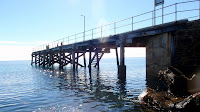
Leafy seadragon (taken by Neville Skinner)
We are indeed very fortunate in this day and age when it comes to Leafy seadragons. I don’t recall having had any knowledge of Leafy seadragons when I decided to take up scuba diving in 1978, even though I had been keeping marine aquariums during the 1970s.
The next day after completing my scuba course in February 1978, I dived with the (now) Marine Life Society of SA at the Bluff at Victor Harbor. It was reported that a Leafy seadragon was sighted during that dive but I have no recollection of it at all.
The first time that I recall seeing a Leafy seadragon was also at the Bluff some time later. One of the Marine Life Society members displayed one in a dive tub after our dive.
Back in those days, my fish ‘bible’ was a copy of “The Marine and Freshwater Fishes of South Australia”, a handbook of the Flora and Fauna of South Australia, issued by the Handbooks Committee on behalf of the South Australian Government.
The 2nd edition of ‘Marine & Freshwater Fishes’ had been published in 1974. The 1st edition had been published back in 1962. Both editions were full of wonderful black and white pictures of SA fish species. I would often gaze in wonder at the picture of a Leafy seadragon in my copy of the book.
A facsimile reprint of “The Marine and Freshwater Fishes of South Australia” was published in February 1980. This new version featured 42 colour photographs of different fish species, including one of a Leafy seadragon in an aquarium. Despite it being a beautiful fish, the photograph was not particularly inspiring.
I had still not managed to see a seadragon during any of my dives despite diving fairly regularly between 1978 and 1980. I had performed more than 70 dives without enjoying the exhilaration of spotting a seadragon. That all changed dramatically in May 1980. That was when I came across a Weedy seadragon at a depth of 18m at Seaford. Although I was ecstatic over this development in my diving experiences, still no Leafy.
My very next dive was at the Rapid Bay jetty later that same month. Members of the Marine Life Society were collecting fish beneath the jetty so that they could be photographed in an aquarium that had been set up on the jetty. I was again ecstatic when I found a Leafy seadragon, which was then hoisted up on to the jetty in a bucket. Several photos were taken of the amazing creature in the aquarium, under the gaze of several Society members and enthralled members of the public. One of the divers later returned the beautiful seadragon to the jetty bottom.
The sighting of a Leafy seadragon at Rapid Bay jetty is a common occurrence these days, but it wasn’t so back then. It was still considered to be a rarity for the next few years, despite sightings occurring more often in the late 1980s.
The Marine Life Society adopted the Leafy seadragon for its logo in 1982. Divers started sighting both Leafy and Weedy seadragons regularly at Rapid Bay jetty and the jetty soon became known as being one of the best spots to see both species of seadragons.
The Marine Life Society had begun recording seadragon sightings by the early 1990s. An article about the Leafy seadragon in the Marine Life Society’s 1991 Journal claimed that not a great deal had been written about the creature to that stage. That Journal tried to change all of that by featuring only articles about seadragons and this ultimately led to the formation of DragonSearch around late 1994.
Articles and photographs featuring seadragons were now starting to become very popular with the general public and within government circles. From the time of those first photos of a Leafy seadragon in an aquarium at Rapid Bay jetty, the Marine Life Society had been gathering a collection of seadragon images as part of its Photographic Index of SA Marine Life. In 1999, the Society was able to publish its first calendar of SA marine life using images from its Photographic Index. A Leafy seadragon featured on the front cover of the 1999 calendar and seadragon shots have been popular features of the annual calendar ever since then.
These days, we really are spoilt. We now have many informative books full of colour photographs of fish, including seadragons. Just about everyone that scuba dives these days carries a digital camera. Seadragon photos are now featured on numerous websites. There have been many television documentaries about seadragons and some are available on video and DVD. The Gould League’s “Seahorses and Seadragons” poster is very popular with divers and students. The Leafy seadragon really has become an icon species, which has boosted sales of everything from mouse mats and stubby holders to designer tops.
All that is required now is for us to ensure the long-time survival of seadragons by protecting their habitat from the many threats that it faces today.
 Second Valley jetty B4 the collapsed steps were removed
Second Valley jetty B4 the collapsed steps were removed















































